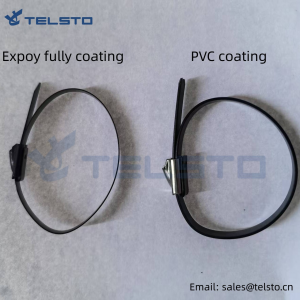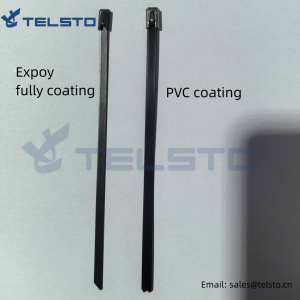PVC-coated cable ties combine the strength of a nylon or stainless-steel core with the protective PVC covering, making them suitable for everyday outdoor and light-industrial use. They resist abrasion, moisture, and mild chemical exposure, yet are easy to install and won’t scratch bundled items. With a 0.8 mm coating, they strike an optimal balance between flexibility and durability. Common applications include garden repairs, construction bundling, household appliance assembly, light-duty industrial packaging, and low-voltage cable management—providing a cost-effective, practical solution for both professionals and DIY enthusiasts.


What Are PVC-Coated Cable Ties?
PVC-coated cable ties consist of a core (usually nylon or stainless steel) wrapped in a layer of polyvinyl chloride (PVC). This coating enhances grip, protects surfaces from scratches, and offers resistance to UV rays, moisture, and light chemicals.
Application Scenarios
General Outdoor Use: Ideal for securing bundles on construction sites, anchoring temporary fencing, or fixing garden trellises. The PVC layer outperforms plain nylon in rain and sunlight, making it perfect for supporting young trees and organizing irrigation lines.
Home & DIY Repairs: Great for quickly tidying cables behind media centers, fastening decor items, or hanging tools on workbenches—the smooth PVC finish prevents surface damage.
Light-Duty Industrial Packaging: Used in warehouses or light manufacturing to bundle hoses, small parts, or cables; colored PVC ties can also serve as visual identifiers.
Low-Voltage Cable Management: Perfect for organizing network cables, speaker wires, or control-panel wiring, ensuring neat runs without nicking or damaging insulation.
Typical Industries
Household Appliances: During assembly, ties secure wiring harnesses to prevent abrasion and short circuits.
Light Industry Packaging: Manufacturers use them to bundle finished hoses or components, protecting surfaces during transit.
Electrical & Electronics: Technicians rely on them for clean, safe routing of network, audio, and control wiring.
Key Features & Benefits
0.8 mm Coating Thickness: Provides cushioning against abrasion while maintaining the tie’s flexibility for tight bundles.
Abrasion & Corrosion Resistance: The PVC layer protects against light chemicals, moisture, and rough surfaces, extending service life.
Easy Installation: The self-locking head enables one-handed application; cut flush with side cutters for a clean finish.
Cost-Effective & Versatile: Available in various lengths, tensile strengths, and colors, making them an economical choice for general-purpose use.
Manufacturing Process
First, the tie core is extruded or injection-molded. Next, a continuous PVC extrusion line applies a uniform 0.8 mm coating over each tie. After cooling, ties are cut to length, the head is formed, and they are packaged. This process ensures consistent coating thickness and adhesion, meeting the demands of outdoor and light-industrial applications.
Epoxy Resin Powder-Coated Cable Ties
Epoxy resin powder-coated cable ties combine a stainless-steel or high-strength nylon core with a 0.35 mm epoxy resin powder coating, offering outstanding chemical resistance, high-temperature performance, and electrical insulation for the harshest environments. They are widely used where corrosion resistance, high-voltage insulation, or extreme durability is required—such as in power systems, oil and gas pipelines, automotive manufacturing, and aerospace.


What Are Epoxy Resin Powder-Coated Cable Ties?
Epoxy resin powder-coated cable ties consist of a core (stainless steel, grade 304 or 316, or high-strength nylon) uniformly covered with a 0.35 mm layer of thermoset epoxy resin powder. The coating is applied via a 360° spray process that fully encapsulates the tie and fills microscopic gaps, providing far superior corrosion resistance compared to standard PVC coatings, while also delivering high dielectric strength.
Application Scenarios
Chemical Processing Equipment: Securing wires and tubing in reactors, mixers, and piping exposed to strong acids and alkalis.
Marine Engineering: Withstanding salt spray, seawater immersion, and UV exposure in shipbuilding, offshore platforms, and dockside installations.
High-Temperature Workshops: Operating reliably from –60 °C to +150 °C, ideal for environments around furnaces, kilns, and heat-treatment lines.
Corrosive Environments: Resisting hydrogen sulfide, chlorine, and other corrosive agents in oil and gas pipelines, refineries, and petrochemical plants.
Typical Industries
Power Systems: Bundling high-voltage cables and insulators in substations, transformers, and switchgear, where insulation and corrosion protection are critical.
Oil & Gas Pipelines: Securing sensor cables, cathodic protection wires, and heat-trace lines along onshore and offshore pipelines.
Automotive Manufacturing: Routing harnesses in engine bays and under-body areas exposed to road salt and engine fluids.
Aerospace: Fastening wiring looms in aircraft fuselages and engine nacelles, meeting stringent requirements for weight, vibration resistance, and flame retardancy.
Key Features & Benefits
0.35 mm Thin Coating: Balances flexibility for tight bundling with a durable protective barrier.
Exceptional Chemical Resistance: Outperforms uncoated or PVC-coated ties against acids (e.g., sulfuric, acetic), alkalis, solvents, and saltwater.
Wide Temperature Range: Reliable performance from –60 °C up to +150 °C in extreme low- and high-temperature environments.
High Dielectric Strength: Suitable for insulating cables at voltages up to several kilovolts, preventing electrical tracking and shorts.
UV-Stable & Weather-Resistant: Thermoset epoxy resists UV degradation, ensuring long service life in outdoor applications.
Manufacturing Process
Core Preparation: Stainless-steel or nylon ties are cleaned and surface-treated to promote epoxy adhesion.
Powder Spray Coating: A fluidized-bed or electrostatic spray process applies a uniform 0.35 mm epoxy powder layer over each tie.
Curing: Coated ties pass through a curing oven where the epoxy thermosets into a continuous, tightly bonded coating.
Cutting & Inspection: After cooling, ties are cut to length, heads are formed, and QA checks verify coating thickness and adhesion before packaging.
By combining these attributes, epoxy resin powder-coated cable ties deliver secure, long-lasting bundling solutions in the most demanding industrial, marine, and aerospace environments.
Post time: Jun-06-2025
